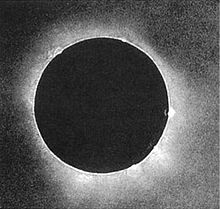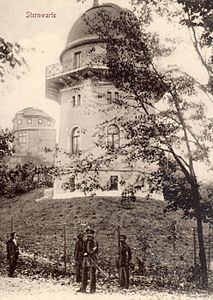Koenigsberg observatory
The Königsberg observatory was an astronomical research facility that was affiliated with the Albertus University of Königsberg . Important astronomers such as Friedrich Wilhelm Bessel , Friedrich Wilhelm Argelander and Arthur Auwers worked on it . In 1838 an exact value of the parallax of a fixed star could be determined there for the first time . The observatory existed from 1813 to 1944.
history
In the years 1809/1810 the Prussian government decided on a program to expand the University of Königsberg during a period of rest during the Napoleonic wars, under the leadership of the educational reformer Wilhelm von Humboldt . This included the establishment of an observatory .
In 1809 the astronomer Friedrich Wilhelm Bessel received a call to Königsberg from the Lilienthal observatory to teach at the university and to take over the management of the planned observatory. When Bessel arrived in Königsberg in 1810, the observatory was only in the planning phase. Bessel first had to look for a suitable site with a horizon-free view for the observatory and finally found it in the northwest of the city on the Butterberg near the fortifications. Construction, which began in 1811, was tailored entirely to Bessel's wishes. Bessel remarked about the financial expenditure:
“It may seem strange that so much is used in an observatory these days; but the times when the military took everything away are over, and so the lively interest in scientific matters becomes more understandable. In this respect, our government is a model for everyone else. "
Due to the lack of the possibility of setting up the device, observations could only be made to a limited extent with the devices already in place. In the first few years, Bessel therefore continued evaluating the observations made by the British astronomer James Bradley and compiled a star catalog with 3,000 stars. The basic work entitled Fundamenta astronomiae was published in 1818.
With a meridian circle from Reichenbach , which was purchased in 1819, Bessel himself determined the positions of stars with the greatest possible instrumental accuracy at the time. In the following years he determined the locations of 30,000 stars, and he also involved his students in the practical measurements. From 1820 to 1823 Friedrich Wilhelm Argelander was Bessel's assistant.
In 1829 a heliometer from the workshop of Joseph von Fraunhofer was purchased with which the diameters of planar celestial bodies such as the sun and planets as well as the angular distances between stars that are optically close together in the sky can be measured precisely. With this instrument, Bessel devoted himself to a problem that had been known for 300 years but could not be solved - the measurement of the parallax of the stars. As the earth revolves around the sun and the earth's position changes with it, the stars themselves would have to show an apparent annual periodic change in location, which is greater the closer a star is to the earth. For his investigations, Bessel chose the star 61 Cygni in the constellation Swan , the distance of which is obviously relatively small due to its high intrinsic motion . Over a year, Bessel measured the distance between 61 Cygni and some optically neighboring, but actually much more distant stars. After computational evaluation, he was able to demonstrate a shift of 1/3 of an arc second . The determination of the star parallaxes was of great importance because for the first time a statement about the distance of the stars from the solar system could be made. Thus, the Copernican view of the world was also proven by measurements.
As a result of Bessel's work, Königsberg became one of the leading astronomical research centers in Europe.
The death of the first director in 1846 marked a turning point for the observatory. The management of the observatory was given to Bessel's observer August Ludwig Busch (1804–1855) and was decoupled from the professorship in astronomy. After Busch's death, Eduard Luther and Moritz Ludwig Georg Wichmann (1821–1859) shared management. After Wichmann's death, the directorate of the observatory was reunited with the professorship for astronomy in the hands of Luther (until 1887).
In 1851 the first photographic image of a total solar eclipse was made as a daguerreotype at the Königsberg observatory .
Arthur Auwers worked as an assistant from 1859 to 1862 . He determined the proper motion of the star Prokyon . Carl Friedrich Wilhelm Peters acted as Luther's successor from 1888 until his death in 1894 . In 1895 Hermann von Struve took over the management of the observatory. After he moved to the Berlin observatory in 1904 , Hans Battermann took over the post until 1919. From 1921 until the end of the Second World War, the management was in the hands of Erich Przybyllok .
The air raids on Königsberg in August 1944 severely damaged the observatory and numerous other university buildings. During the Battle of Königsberg there was a command post of the Wehrmacht in the nearby bastion observatory , which could be held until the surrender on April 9, 1945. Thus the observatory area was in the area of fighting until the end.
Furnishing
The first instruments came mainly from the Remplin observatory of the amateur astronomer Friedrich von Hahn in Mecklenburg and came to Königsberg through the mediation of Johann Elert Bode . It was a meridian telescope (called "Cary Circle" - the instrument is now in the Deutsches Museum in Munich ) with a 2 inch (5 cm) aperture and 1 m focal length , a "midday telescope" from Dolland with 1.3 m Focal length and 2.7 inch (7 cm) aperture, an "equatorial telescope" with 33 cm focal length, a short focal length telescope ("comet seeker"), two mirror sextants and a pendulum clock .
The later main instrument of the observatory was the refractor with 13 inch (32.5 cm) opening, acquired in 1819 . The heliometer purchased in 1829 came from the workshop of Joseph von Utzschneider in Munich. The work on this heliometer, which began under the factory management of Joseph Fraunhofer , was successfully carried out by his successors Georg Merz and Franz Joseph Mahler . In 1841 the Prussian King Friedrich Wilhelm IV gave the observatory a meridian circle by Adolf Repsold .
Picture gallery
- Koenigsberg observatory
Reproduction of a daguerreotype of Friedrich Wilhelm Bessel's study
literature
- Dietmar Fürst: The establishment of the Königsberg observatory in the light of the files of the Prussian state. Contributions to the history of astronomy, Volume 1 (1998), pp. 79-106 ISBN 3-8171-1568-7 ; Volume 2 (1999), pp. 145-188 ISBN 3-8171-1590-3 ; Volume 3 (2000), pp. 22-67 ISBN 3-8171-1635-7
- Dietmar Fürst: The history of the heliometer at the Königsberg observatory. Contributions to the history of astronomy, Volume 6 (2003), pp. 90-136 ISBN 3-8171-1717-5
- Dieter B. Herrmann : Bessel's library at the Königsberg observatory. In: The Stars. Volume 61 (1985), pp. 96-103 (with a photo of the observatory ruins from the post-war period).
- Friedrich Wilhelm Bessel: Astronomical observations at the Royal University Observatory in Königsberg , Volume 1 (1815), pp. Ii - xxi.
Individual evidence
- ↑ Royal Prussian Academy of Sciences (ed.): Correspondence between Gauss and Bessel. Leipzig 1880, p. 144 (letter from Bessel to Gauß of March 10, 1811)
- ^ First photograph of a solar eclipse
Coordinates: 54 ° 42 ′ 47 " N , 20 ° 29 ′ 40" E






